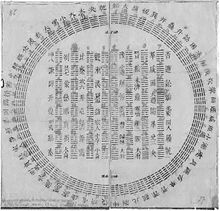
Back Vierundsechzig Hexagramme German Hexagrama (I Ching) Spanish Kuusjoon Estonian Hexagramme Yi Jing French 六十四卦 Japanese Hexagram (I Tjing) Dutch Hexagramas (I Ching) Portuguese Гексаграмма (И цзин) Russian Шістдесят чотири знаки Ukrainian 六十四卦 Chinese

The I Ching book consists of 64 hexagrams.[2] [3] A hexagram in this context is a figure composed of six stacked horizontal lines (爻 yáo), where each line is either Yang (an unbroken, or solid line), or Yin (broken, an open line with a gap in the center). The hexagram lines are traditionally counted from the bottom up, so the lowest line is considered line one while the top line is line six. Hexagrams are formed by combining the original eight trigrams in different combinations. Each hexagram is accompanied with a description, often cryptic, akin to parables. Each line in every hexagram is also given a similar description.
The Chinese word for a hexagram is 卦 "guà", although that also means trigram.
© MMXXIII Rich X Search. We shall prevail. All rights reserved. Rich X Search